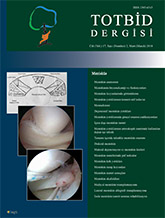
These are cysts which contain mucoid material, and are located inside or connected with the meniscus. Mucoid degeneration (MD) is a major factor in the etiology of meniscal cysts. It is also believed that intrameniscal cysts are formed by local accumulation of joint fluid in the torn or degenerated meniscus tissue. Parameniscal cysts occur when the joint fluid reaches the meniscal periphery through the meniscal tear (one-way valve mechanism). Intrameniscal tear is formed by the damage of the collagen fibers extending vertically in the meniscus structure, and this intrameniscal tear is filled with mucoid material. If the intrameniscal tear extends to the central zone, it opens into the joint, and a horizontal meniscal tear is formed in the degenerative zone. If the pathology extends to the periphery of the joint, the mucoid material accumulates in the periphery and forms the parameniscal cyst, and this cyst has a direct connection with the intrameniscal tear. If intrameniscal tear extends to both sides, a parameniscal cyst associated with horizontal meniscal tear is formed. Lateral compartment involvement is frequently observed clinically. Small-sized meniscus cysts may not cause symptoms; the most important complaint is pain in symptomatic patients; tenderness with palpation and swelling in the lateral side of the knee can usually be detected. Medial meniscal masses due to meniscal cysts are rarely seen, because the cysts are located inside the meniscus (stromal mucoid degeneration), and if a cyst develops, it arises from the medial meniscus posterior horn and is palpated as a large swelling posteromedially. Magnetic resonance imaging examination plays an important role in the diagnosis of meniscal cyst and associated meniscus tear. Clinical results are similar in long-term follow-up with cyst decompression done either inside-out or outside-in following arthroscopic treatment of the meniscal tear.